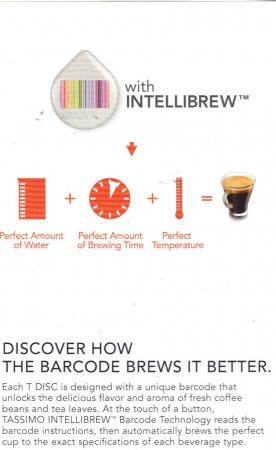While having our family dinner the other night, my wife handed me a small brochure from a company called TASSIMO. TASSIMO has a product line of intelligent beverage brewers that utilize bar codes to automatically brew the proper cup of coffee, latte, cappuccino, and expresso.
Intellibrew Bar Code Technology
Their web site explains the bar code technology: “Using INTELLIBREWTM, the TASSIMO single cup brewer reads instructions on each T DISC pod to make sure every beverage it brews tastes exactly as it should. This Intelligent Barcode Technology measures the right amount of water to brew the most delicious latte. It creates the perfect amount of foam needed to make a creamy cappuccino. And it knows the precise brew time to make the richest and boldest espresso.”
My wife wanted to know how the brewer knows what and how to brew based on reading a bar code. While this premise is very cool, since we are not coffee drinkers, we don’t really have a need for a brewer. But since I make a living helping others with their bar code applications, and since my wife rarely discusses bar codes, I felt obligated to further explore TASSIMO’s Intellibrew technology.
1D Bar Codes and Reference Numbers
At first glance, the bar codes are colorful. They are linear 1D bar codes that include every color in the spectrum. The question is what is the data on each bar code? In a prior article “Bar Codes: Between The Lines,” I explain in detail how bar codes work. Since these are 1D bar codes, there is a single string of data. So, most likely the bar code reader isn’t reading instructions of text, but most likely just referencing numbers or other characters on each bar code.
When I printed and scanned a bar code from their site, it may have just been a decorative barcode—I was not able to read any data or decode it at all. Hopefully I can pin down a sample T Disc from a store, or at least purchase a couple for R&D that can be scanned to show what data is present!
How It Works-The Bar Code Magic Explained
Let’s try to analyze how this technology most likely works. Here is an example. Let’s suppose that a particular brewer has some settings for the type of beverage, the amount of water to pour, the perfect brewing time, and the perfect temperature. Now if we were to enter these manually we may look over a matrix or chart to see which values to set. We may select the following: coffee, 8OZ, 5 minutes, 130 degrees.
When the brewer scans the bar code on the particular Tdisk container, it most likely only references codes for programming instructions. So in the case above a bar code may read C85130. “C” denotes coffee, “8” denotes # of ounces, “5 denotes the brewing time, and “130” denotes the brewing temperature. As the bar code is being read, each character on the code acts as a reference number for a database of instructions. The database may include a column for each parameter, and a row for each choice. For example the “coffee” column in the database may be C (coffee), L (latte), P (cappuccino), E (expresso). In the case above there was a “C”, so the “type of jo” column is quickly searched until it finds the “C”, and so on.
Another potential option may also be to utilize the color of the code. While this one may sound more far- fetched, at least it still gets us thinking about the automation process and utilizing bar codes to do so. In the case above perhaps the color that is at the beginning of the code denotes the “type of jo”, the color that follows denotes size, the 3rd color the reader sees would denote the brewing time, and the 4th color denotes brewing temperature. This method is not widely used, and would require a proprietary bar code reader installed in each brewer.
Finally, a simpler method may be to just have a database with similar values, and each Tdisk flavor will have a corresponding numeric code. Here is an analogy: When a loaf of bread is scanned at the store, that particular bar code number is searched in the database until that number is located. Then, the rest of the columns of data are tied to that referenced bar code number: the price of the loaf, the manufacturer of the loaf, and the description of the loaf are then pulled onto the cash register receipt. Magic, no, but, cool, yes!
Published:


